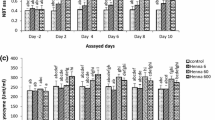Abstract
This study was undertaken to determine the effect of chronic exposure to sub-lethal concentrations of tannery effluent (TE) on the humoral antibody response and the cell-mediated immune response of the fish Cyprinous carpio. The LC50 value of the TE for C. carpio was determined by bioassay to be 3.8%. Sub-lethal concentrations of TE (0.6% and 0.3%) significantly suppressed the humoral and cell-mediated immune responses. Exposure of C. carpio to the TE had a significant effect on mean acceptance time (MAT) for transplanted scales. MAT was found to be 5–8 days for autografts and 4–7 days for allografts. The somatic indices of the kidney and spleen were reduced compared with controls.


Similar content being viewed by others
References
Abbott WS (1925) A method of computing the effectiveness of an insecticide. J Econ Entomol 18:265–267
Arfstein DP, Aylward LL, Karch NJ (1998) Chromium. In: Zelikoff JT, Thomas PT (eds) Immunotoxicology of environmental and occupational metals. Taylor & Francis, London, pp 63–92
Arunkumar RI, Rajasekaran P, Michael RD (2000) Differential effects of chromium compounds on the immune response of the African mouth breeder Oreochromis mossambicus (Peters). Fish Shellfish Immunol 10:667–676
Billingham RE, Brent L, Medawar PB (1956) Enhancement in normal homografts with a note on its possible mechanism. Transpl Bull 3:84–88
Borella P, Manni S, Giardino A (1990) Cadmium, nickel, chromium and lead accumulate in human lymphocytes and interfere with PHA-induced proliferation. J Trace Elem Electrolytes Health Dis 4:87–95
Cossarini DM (2006) Effects of the pesticides atrazine and lindane and of manganese ions on cellular immunity of carp, Cyprinus carpio. J Fish Biol 31:67–73
Craddock DR (1977) Use and limitations of acute toxicity test—a review. In: Malins Dc (ed) Effect of 50 on arctic and sub arctic marine environment and organism. Academic press, New York, pp 1–93
Dawley RM, Yeakel AM, Beaulieu KA, Phiel KL (2000) Histocompatibility analysis of clonal diversity in unisexual hybrids of the killifishes Fundulus heteroclitus and Fundulus diaphanous. Can J Zool 78:923–930
Hildemann WH (1957) Scale homotransplantations in goldfish (Carassius auratus). Ann N Y Acad Sci 64:775
Khangarot BS, Rathore RS, Tripathi DM (1999) Effects of chromium on humoral and cell-mediated immune responses and host resistance to disease in a freshwater catfish, Saccobranchus fossilis (Bloch). Ecotoxicol Environ Saf 43:11–20
Khwaja AR, Singh R, Tandon SN (2001) Monitoring of Ganga water and sediments vis-à-vis tannery pollution at Kanpur (India): a case study. Environ Monit Assess 68:19–35
Koteswari YN, Ramanibai R (2003) Impact of tannery effluent in the colonization of plankters: a microcosm study. Turk J Bioil 27:163–170
Lamers Billard J, Marcel R (1986) The immune system of Cyprinid fish: a review. Aquaculture of cyprinids. INRA Publications, Paris
Mafzoub MB, Al-Batshan HA, Hussein MF, Al-Mufarrej, Al-Saiady MY (2009) The effect of source and level of dietary chromium supplementation on humoral antibody response and blood chemical parameters in hybrid tilapia fish (Oreochromis niloticus X O. aureus). Res J Biol Sci 4(7):821–827
Mahdavi Talarposhti A, Donnelly T, Andersonm GK (2001) Color removal from a simulated dye wastewater using a two-phase anaerobic packed bed reactor. Water Res 35:425–432
Pathan TS, Sonawane DL, Khillare YK (2009) Toxicity and behavioural changes in freshwater fish Rasbora daniconius exposed to paper mill effluent. Bot Res Int 2(4):263–266
Prabakaran M, Binuramesh C, Steinhagen D, Dinakaran Michael R (2007) Immune response in the tilapia, Oreochromis mossambicus on exposure to tannery effluent. Ecotoxicol Environ Saf 68(3):372–378
Sekar P, Hari Prasad S, Decca Raman M (2009) Effect of textile dye industry effluent on the nutritive value of fresh water female crab Spiralothelphusa hydrodroma (Herbst). J Appl Sci Res 5(11):2041–2048
Snyder CA, Valle CD (1991) Lymphocyte proliferation assays as potential biomarkers for toxicant exposures. J Toxicol Environ Health 34:127–139
Sudhan T, Michael RD (1995) Modulation of humoral immune response by tannery effluent in Oreochromis mossambicus (Peters). Indian J Exp Biol 33:793–795
Witlin B (1967) Detection of antibodies by microtitration techniques. Mycopath Mycol Appl 33(3–4):241–257
Author information
Authors and Affiliations
Corresponding author
Rights and permissions
About this article
Cite this article
Murugesan, A.G., Ramathilaga, A., Samson Ponselvan, J.K. et al. Immunotoxicity of Tannery Effluent to the Freshwater Fish Cyprinous carpio . Bull Environ Contam Toxicol 88, 639–643 (2012). https://doi.org/10.1007/s00128-011-0511-9
Received:
Accepted:
Published:
Issue Date:
DOI: https://doi.org/10.1007/s00128-011-0511-9




